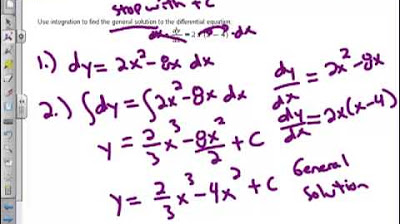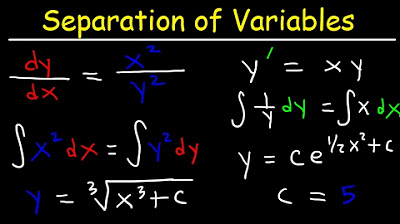Simple Differential Equations
TLDRThis video introduces the concept of differential equations, emphasizing their importance in mathematics. It explains the meaning of differentials and provides a step-by-step method for solving basic first-order differential equations using examples. The video also highlights that the solutions to differential equations are functions, not single numbers, and demonstrates how initial conditions can be used to find particular solutions.
Takeaways
- 📚 Differential equations are mathematical equations that involve differentials, such as dy/dx.
- 🌟 A differential represents an infinitely small change in a variable, for example, dy is a differential in y and dx is a differential in x.
- 🔍 The process of solving a differential equation often involves taking the antiderivative or integral of both sides of the equation.
- 📈 The solution to a differential equation is typically a function rather than a single number, indicating which function satisfies the equation.
- 🎯 For a given differential equation dy/dx = x^2 + 1, the solution is y = (x^3)/3 + x + C, where C is an arbitrary constant.
- 📌 Initial conditions or specific points on the function can be used to find the particular solution by determining the value of the arbitrary constant.
- 🤔 When solving dy/dx = x/y, the resulting equation is y^2 - x^2 = C, which can be rewritten as y^2 = x^2 + C, leading to the conclusion that y = ±x if C = 0.
- 🧩 For the equation dy/dx = √(x)/y, the general solution is y^(3/2) - x^(3/2) = C, and using the initial condition y(1) = 4, the particular solution is y^(3/2) - x^(3/2) = 7.
- 🔑 When solving differential equations, it's important to consider the implications of taking roots, such as square roots, and ensuring the correct sign.
- 📊 The method of solving differential equations demonstrated in the script can be applied to a variety of situations and forms the basis for more advanced studies in the field.
Q & A
What is the main topic of the video?
-The main topic of the video is the introduction to differential equations.
What is a differential and how does it relate to derivatives?
-A differential represents an infinitely small change in a variable, similar to the concept of a derivative. It is used to describe the rate of change of a function at any given point.
What is the first example of a differential equation given in the video?
-The first example of a differential equation given in the video is dy/dx = x^2 + 1.
How is the differential equation dy/dx = x^2 + 1 solved in the video?
-The differential equation is solved by multiplying both sides by dx, integrating both sides, and then applying the initial condition to find the constant of integration.
What is the general solution to the differential equation dy/dx = x^2 + 1?
-The general solution to the differential equation is y = (1/3)x^3 + x + C, where C is the constant of integration.
How does the solution to a differential equation differ from the solution to a traditional algebraic equation?
-The solution to a differential equation is a function that satisfies the equation, whereas the solution to a traditional algebraic equation is a specific value or set of values for the variable.
What is the second differential equation example provided in the video?
-The second differential equation example is dy/dx = x/y, with the initial condition that y = 1 when x = 1.
What is the general solution to the second differential equation dy/dx = x/y?
-The general solution to the second differential equation is y^2/2 - x^2/2 = C, where C is an arbitrary constant.
What is the particular solution to the second differential equation given the initial condition?
-The particular solution to the second differential equation, given the initial condition y = 1 when x = 1, is y^2 - x^2 = 0, which can also be written as y^2 = x^2.
What is the third differential equation example provided in the video?
-The third differential equation example is dy/dx = sqrt(x)/y, with the initial condition that y = 4 when x = 1.
How can one find the particular solution to a differential equation?
-To find the particular solution to a differential equation, one must apply the given initial conditions or known points on the function to solve for the constant(s) present in the general solution.
Outlines
📚 Introduction to Differential Equations
This paragraph introduces the concept of differential equations, starting with the basics of differentials. It explains that a differential represents an infinitely small change in a variable and uses the notation dy for the differential of y and dx for the differential of x. The paragraph then presents a simple differential equation, dy/dx = x^2 + 1, and explains how to solve it by multiplying both sides by dx and integrating, leading to the general solution y = (x^3)/3 + x + C. The importance of understanding that the solution to a differential equation is a function, not a single number, is emphasized. The paragraph also discusses the use of initial conditions to find the particular solution and illustrates this with an example where y = 1 when x = 1.
🔍 Solving a First-Order Differential Equation
This paragraph delves into solving a first-order differential equation with the given condition y = 1 when x = 1. The equation dy/dx = x^2 + 1 is used to find the particular solution by applying the initial condition. The process involves rearranging the general solution to isolate the constant of integration, c, and then substituting the initial condition to solve for c. The particular solution obtained is y = x^3/3 + x - 1/3. The paragraph also introduces another differential equation dy/dx = x/y with the same initial condition and explains the steps to find its general solution, which involves separating the variables and integrating both sides. The importance of considering the domain of the solution when taking square roots is highlighted.
🧠 Advanced Differential Equation Techniques
The paragraph presents a more complex differential equation dy/dx = √(x)/y with an initial condition y = 4 when x = 1. It outlines the process of solving this equation by multiplying both sides by dx and then by √y (or y^(1/2)) to simplify the equation into dy = (x^(1/2)) dx. The antiderivative of the left side leads to the general solution y^(3/2) - x^(3/2) = C, where C is an arbitrary constant. Using the initial condition, the particular solution is found by substituting y = 4 and x = 1 into the general solution, resulting in C = 7. The final particular solution is expressed as y^(3/2) - x^(3/2) = 7. The paragraph cautions about the potential for error when taking square roots of both sides of an equation without considering the implications of the plus or minus sign.
Mindmap
Keywords
💡Differential
💡Differential Equation
💡Antiderivative
💡Integration
💡Initial Conditions
💡Solving Differential Equations
💡Constants
💡Rate of Change
💡Slope
💡Functions
💡Manipulation of Differentials
Highlights
Introduction to differential equations and the concept of differentials.
Explanation of differential notation and its application in equations.
Derivation of the differential equation dy/dx = x^2 + 1.
Process of solving a differential equation by multiplying both sides by dx.
Integration method to find the antiderivative of both sides of a differential equation.
Explanation of the antiderivative of x^2 + 1 and its components.
Introduction to the general solution of a differential equation.
Difference between traditional equations and differential equations in terms of solutions.
Example of solving a differential equation with initial conditions to find the particular solution.
Demonstration of solving the differential equation dy/dx = x/y with given initial conditions.
Use of implicit differentiation in finding the function that satisfies a differential equation.
Process of isolating y in the equation y^2 - x^2 = c to find the general solution.
Explanation of why taking the square root of both sides of an equation must be done with caution.
Another example of a differential equation involving the square root of x over y.
Step-by-step method of solving the differential equation by multiplying both sides by dx and rearranging terms.
Integration of the modified differential equation to find the antiderivative.
Explanation of the relationship between the constants in the general solution of the differential equation.
Utilization of initial conditions to determine the particular solution of the differential equation.
Final expression of the particular solution y^(3/2) - x^(3/2) = 7.
Transcripts
Browse More Related Video

Finding Particular Solutions of Differential Equations Given Initial Conditions

Differential Equations with Velocity and Acceleration (Differential Equations 7)

Separation of Variables

AP Calculus AB: Lesson 7.2 Slope Fields

Differential Equations BC Calculus

Separable First Order Differential Equations - Basic Introduction
5.0 / 5 (0 votes)
Thanks for rating: